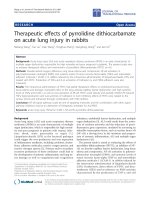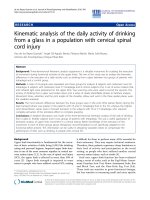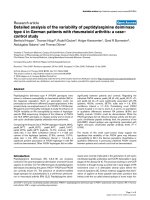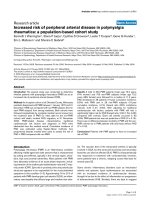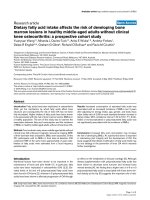Increased risk of everolimus-associated acute kidney injury in cancer patients with impaired kidney function
Bạn đang xem bản rút gọn của tài liệu. Xem và tải ngay bản đầy đủ của tài liệu tại đây (331.26 KB, 7 trang )
Ha et al. BMC Cancer 2014, 14:906
/>
RESEARCH ARTICLE
Open Access
Increased risk of everolimus-associated acute
kidney injury in cancer patients with impaired
kidney function
Sung Hae Ha1,2, Ji Hyeon Park1, Hye Ryoun Jang1, Wooseong Huh1, Ho-Yeong Lim3, Yoon-Goo Kim1, Dae Joong Kim1,
Ha Young Oh1 and Jung Eun Lee1*
Abstract
Background: Everolimus was recently introduced as a second-line treatment for renal cell carcinoma (RCC) and
many other cancers. Several prospective studies have shown that serum creatinine levels are increased in a
significant proportion of patients receiving everolimus. However, data on the occurrence of acute kidney injury
(AKI) during everolimus treatment in clinical practice are sparse. Here, we report the incidence, risk factors,
and clinical significance of AKI associated with everolimus treatment in patients with cancer.
Methods: We analyzed patients who received everolimus for more than 4 weeks as an anticancer therapy. AKI was
defined as increase in creatinine levels from baseline levels greater than 1.5-fold.
Results: The majority of the 110 patients enrolled in this analysis had RCC (N=93, 84.5%). AKI developed in 21 (23%)
RCC patients; none of the patients (N=17) with other cancers had AKI. Fourteen of 21 cases were considered to be
everolimus-associated AKI, in which there were no other nephrotoxic insults other than everolimus at the onset of
AKI. The incidence of AKI increased progressively as baseline estimated glomerular filtration rate (eGFR) decreased
(10% in subjects with eGFR >90 mL/min/1.73 m2, 17% in subjects with eGFR 60–90 mL/min/1.73 m2, 28% in
subjects with eGFR 30–60 mL/min/1.73 m2, and 100% in subjects with eGFR 15–30 mL/min/1.73 m2; P=0.029
for trend). Baseline eGFR was an independent risk factor for the development of everolimus-associated AKI (hazard
ratio per 10 mL/min/1.73 m2 increase, 0.70; 95% confidential interval, 049–1.00; P=0.047). Nine of 14 patients with
everolimus-associated AKI continued receiving the drug at a reduced dose or after a short-term off period.
Administration of the drug was discontinued in four of 14 patients because of progression of an underlying
malignancy. Only one patient stopped taking the drug because of AKI.
Conclusions: This paper suggests that AKI is a common adverse effect of everolimus treatment, especially in
subjects with impaired renal function. However, the occurrence of AKI did not require the discontinuation of the
drug, and the treatment decision should be made via a multidisciplinary approach, including the assessment of the
oncological benefits of everolimus and other therapeutic options.
Keywords: Everolimus, mTOR inhibitor, Adverse effect, Renal cell carcinoma, Acute kidney injury
* Correspondence:
1
Division of Nephrology, Department of Medicine, Samsung Medical Center,
Sungkyunkwan University School of Medicine, Seoul, Korea
Full list of author information is available at the end of the article
© 2014 Ha et al.; licensee BioMed Central Ltd. This is an Open Access article distributed under the terms of the Creative
Commons Attribution License ( which permits unrestricted use, distribution, and
reproduction in any medium, provided the original work is properly credited. The Creative Commons Public Domain
Dedication waiver ( applies to the data made available in this article,
unless otherwise stated.
Ha et al. BMC Cancer 2014, 14:906
/>
Background
Everolimus is a major active metabolite of sirolimus,
which acts as a selective inhibitor of the mammalian
target of rapamycin (mTOR) [1]. Everolimus has been
developed as an immunosuppressant that is administered after solid organ transplantation based on its
antiproliferative properties [1,2]. In particular, an
mTOR-inhibitor-based regimen in which calcineurin
inhibitors are withdrawn or reduced has been evaluated as a maintenance immunosuppressant therapy
to minimize calcineurin-inhibitor toxicity [2,3]. Although
mTOR inhibitors have been considered to lack nephrotoxicity when used alone, the combination of mTOR inhibitors and full-dose calcineurin inhibitors has been shown to
exacerbate nephrotoxicity. Moreover, the nephrotoxicity of
mTOR inhibitors has been demonstrated in patients with
glomerulonephritis and in experimental animal models of
glomerular injury [4,5]. Recently, everolimus received approval for use in the treatment of advanced renal cell carcinoma (RCC) and several other cancers at a dose of
10 mg once daily, which is a higher dose than that used
for immunosuppression [6-8]. Increased serum creatinine
level was one of the frequently reported laboratory abnormalities during observed in a phase 3 trial of everolimus for
metastatic renal cell cancer [6]. However, the information
regarding the nephrotoxicity associated with everolimus,
especially in cancer patients with clinical settings, is sparse.
Therefore, we conducted this research to evaluate the incidence, severity, risk factors, and prognosis of acute kidney
injury (AKI) in patients receiving everolimus as an anticancer therapy. We were particularly interested in patients with
RCC who already had a decreased mass of functioning
nephrons because of nephrectomy, invasion of cancer, or
previous treatment with vascular endothelial growth factor
receptor/tyrosine kinase inhibitors (VEGFR-TKIs).
Methods
Patients
Between January 2009 and September 2013, 140 adult
patients (>18 years of age) who took everolimus as an
anticancer treatment at the Samsung Medical Center
were identified using electronic databases. We excluded
patients who received everolimus for less than 4 weeks
(N = 12), for whom there were insufficient data (N = 17),
or for whom the baseline estimated glomerular filtration
rate (eGFR) was less than 15 mL/min/1.73 m2 (N = 1).
Data from 110 patients were analyzed. At the Samsung
Medical Center, advanced RCC or hepatocellular carcinoma (HCC) that failed VEGFR-TKI treatment was an indication for everolimus treatment. Generally, patients
received 10 mg of everolimus once daily; however, the
dose and schedule could be modified according to toxicity and tolerability. Most patients were followed every
4 weeks and laboratory tests including creatinine were
Page 2 of 7
performed at every visit. This research was approved by
the Institutional Review Board of the Samsung Medical
Center.
Data collection
Demographic data including age, sex, body mass index, the
malignancy that was targeted by everolimus, past medical
history of diabetes mellitus, hypertension, nephrectomy,
medication with angiotensin converting enzyme (ACE)
inhibitors, angiotensin receptor blockers (ARBs) and diuretics, and prior treatment with VEGFR-TKIs were extracted from electronic medical records. Hypertension was
defined as a systolic blood pressure >140 mmHg, a diastolic
blood pressure >90 mmHg, or self-reported hypertension
with or without ongoing pharmacological treatment. Diabetes mellitus was defined as a history of type 1 or type 2
diabetes mellitus treated pharmacologically or controlled by
diet. Information regarding total dosage, treatment duration, and reason for discontinuation of everolimus, as well
as dose modification after AKI, was also collected. Laboratory data, including baseline serum creatinine level (defined
as the latest creatinine within 2 months before treatment),
eGFR, and urinalysis were extracted. eGFR was calculated
using the Chronic Kidney Disease Epidemiology Collaboration (CKD-EPI) equation as follows: eGFR = 141 × minimum (creatinine/κ, 1)α × maximum (creatinine/κ, 1)−1.209 ×
0.993age × 1.018 (if female), where κ is 0.7 for women and
0.9 for men and α is −0.329 for women and −0.411 for men
[9]. Serum creatinine levels were determined every 4 weeks
during treatment, and 1, 3, and 6 months after the discontinuation of everolimus.
The primary outcome was the development of AKI,
which was defined according to the Acute Dialysis Quality Initiative (ADQI) criteria. Briefly, patients were classified in the “risk” category if serum creatinine increased
1.5-fold or eGFR decreased >25%, in the “injury” category if serum creatinine increased 2-fold or eGFR
decreased >50%, and in the “failure” category if serum
creatinine increased 3-fold or eGFR decreased >75%
[10]. Time to AKI was defined as the interval between
the start of everolimus therapy and the onset of AKI.
AKI category was determined based on peak serum creatinine. Recovery from AKI was defined as the return to
a serum creatinine within 1.2-fold of the baseline value.
Everolimus-associated AKI was defined as cases in which
there were no other nephrotoxic insults at the onset
of AKI, such as nephrotoxic drugs, contrast media,
hypotension, infection, urinary tract obstruction, or
volume depletion.
Statistical analysis
Data are expressed as the median with interquartile range
(IQR), or absolute number with percentages. Intergroup
differences were compared using the Mann–Whitney
Ha et al. BMC Cancer 2014, 14:906
/>
U test for continuous variables and Fisher’s exact test or
chi-squared analysis for categorical variables. The cumulative incidence of AKI was determined using the Kaplan–
Meier method. Uni- and multivariate Cox proportional
models were fitted to identify risk factors of AKI. The
multivariate analysis included variables with a P-value <
0.1 according to the univariate analysis. We regarded
P-values < 0.05 as significant. All statistical analyses were
conducted using SPSS 21.0 (IBM Inc., Armonk, NY).
Page 3 of 7
Table 1 Baseline characteristics of the subjects according
to underlying malignancy
RCC (N = 93)
Male sex , no. (%)
Non-RCC (N = 17)
77 (82%)
10 (63%)
Age (years)
59 (52, 67)
54 (48, 59)
BMI (kg/m2)
23.5 (20.0, 25.2)
23.8 (21.4, 25.3)
Diabetes mellitus (%)
17 (18%)
0 (0%)
Hypertension (%)
33 (36%)
2 (11%)
ACE inhibitor/ARB (%)
15 (16%)
1 (6%)
Results
Diuretics (%)
40 (43%)
5 (29%)
Baseline characteristics of the subjects according to
underlying malignancy
Previous TKI Treatment (%)
93 (100%)
9 (53%)
A total of 110 patients met the inclusion criteria, and
the majority of patients (N = 93) received everolimus to
treat RCC. The remaining patients had HCC (N = 7),
pancreas neuroendocrine tumors (N = 5), lymphoma
(N = 2), or other tumors (melanoma, leiomyosarcoma,
and rectal carcinoid, N = 1 for each). Baseline characteristics are shown for the two groups of patients
according to underlying malignancy, RCC vs non-RCC, as
these two groups showed quite different baseline characteristics (Table 1). The median age was 59 years (range,
52–67 years) in the RCC group and 54 years (48–59 years)
in the non-RCC group. In the RCC group, the median
eGFR was 63 mL/min/1.73 m2 (51–76 mL/min/1.73 m2)
and 83 patients (89%) had decreased renal function (defined as GFR values <90 mL/min/1.73 m2), whereas most
individuals in the non-RCC group had normal renal function. In the RCC group, all patients received VEGFR-TKI
therapy, and 74 (80%) patients received radical nephrectomy before treatment with everolimus. Twenty-five (28%)
patients in the RCC group had proteinuria at the baseline.
The total dosage and duration of everolimus treatment
were 1155 mg (670–1900 mg) and 20 weeks (12–36
weeks), respectively, in the RCC group.
Radical nephrectomy
74 (80%)
0 (0%)
1.19 (1.01, 1.43)
0.78 (0.64, 0.86)
63 (51, 76)
104 (94, 132)
10 (11%)
14 (82%)
60–90
41 (44%)
2 (12%)
30–60
40 (43%)
1 (6%)
Creatinine (mg/dL)
eGFR (mL/min/1.73 m2)
>90
15–30
2 (2%)
0 (0%)
25 (28.1%)
0 (0%)
Total dose (mg)
1155 (670, 1900)
790 (332, 1825)
Duration (weeks)
20 (12, 36)
12 (6, 26)
Proteinuria (%)
Everolimus
Data are presented as the median (IQR) or number (%).
RCC, renal cell carcinoma; BMI, body mass index; ACE inhibitor, angiotensin
converting enzyme inhibitor; ARB, angiotensin receptor blocker; TKI, tyrosine
kinase inhibitor; eGFR, estimated glomerular filtration rate.
AKI developed in 21 (23%) patients in the RCC group
during everolimus treatment, whereas none of the patients in the non-RCC group experienced AKI. After exclusion of the patients with other nephrotoxic insults at
the onset of AKI, everolimus-associated AKI developed
in 14 (16.2%) patients. Figure 1A presents the cumulative incidence of AKI in the RCC group. Most cases of
AKI (N = 19, 90%) occurred within 16 weeks of everolimus treatment, and all everolimus-associated AKI cases
occurred within 16 weeks of treatment, with a median
interval of 8 weeks (4–12 weeks) (Figure 1B).
incidence of AKI was 10% in patients with a baseline
eGFR >90 mL/min/1.73 m2, 17% in those with a baseline
eGFR of 60–90 mL/min/1.73 m2, 28% in those with a
baseline eGFR of 30–60 mL/min/1.73 m2, and 100% in
those with a baseline eGFR of 15–30 mL/min/1.73 m2
(P = 0.029 for trend). The incidence of everolimusassociated AKI also increased progressively with decreasing eGFR (P = 0.004 for trend). All patients with a baseline
eGFR <30 mL/min/1.73 m2 experienced AKI.
To identify the risk factors of AKI in patients with
RCC, we used Cox proportional hazard models (Table 2).
On univariate analyses, older age and lower baseline
eGFR were associated with a higher risk of everolimusassociated AKI. Multivariate analysis revealed that baseline eGFR was the only risk factor for AKI, and that an
eGFR increase of 10 mL/min/1.73 m2 was associated
with a 0.7-fold lower risk of AKI (95% confidence interval, 0.49–1.00; P = 0.047). The presence of proteinuria at
the baseline was not independently associated with a
higher risk of AKI.
Association between AKI risk and baseline eGFR in the
RCC group
Outcome and clinical significance of everolimus-associated
AKI in the RCC group
The incidence of all-cause AKI increased progressively
as the baseline eGFR decreased. Figure 2 shows that the
Next, we examined the outcome of everolimus-associated
AKI (N = 14) according to the ADQI criteria. Ten patients
Cumulative incidence of AKI
Ha et al. BMC Cancer 2014, 14:906
/>
Page 4 of 7
Figure 1 Cumulative incidence of all-cause AKI (A) and everolimus-associated AKI (B) in the RCC group.
who remained in the AKI-risk category continued everolimus treatment without renal deterioration. In half of these
patients, the dosage was reduced to 5 mg per day, and two
patients held off the medication for 1 week and 1 month,
respectively, and resumed treatment without dose modification. The remaining three patients discontinued the
drug because of progression of the underlying cancer. In
three patients in the AKI-injury category, kidney function
was recovered after the discontinuation or the reduction
of the dosage of the drug; one of these three patients withheld medication for 2 weeks, and resumed the therapy at
50% of the previous everolimus dose, whereas another patient took everolimus with a 50% dose reduction without
discontinuation of the medication. The remaining patient
in the AKI-injury category discontinued everolimus because of the development of pneumonia, and not of AKI,
and kidney function recovered to the baseline level. One
patient in the AKI-failure category discontinued everolimus treatment eventually, and kidney function recovered
thereafter.
To assess the effects of AKI on treatment decision in
RCC patients, we compared treatment duration and reason for drug discontinuation between the AKI and nonAKI groups (Table 3). Treatment duration was 18 weeks
(9–35 weeks) and 20 weeks (12–36 weeks) in the AKI
and non-AKI groups, respectively, and the total dose of
everolimus was 1050 mg (615–1913 mg) and 1172 mg
(683–1915 mg) in the AKI and non-AKI groups, respectively (not significant; NS). The most common reason for
drug discontinuation in both groups was progression of an
underlying malignancy (67% in the AKI group and 68% in
the non-AKI group; NS).
Discussion
This retrospective analysis examined the incidence, risk
factors, and clinical implications of the development of
AKI during everolimus treatment in real-world cancer
patients. Twenty-three percent of patients who received
everolimus to treat RCC experienced AKI, and 67% of
AKI events were considered everolimus-associated AKI
Figure 2 Incidence of AKI according to baseline eGFR categories in the RCC group. The incidence of all-cause AKI and everolimus-associated AKI
increased progressively with decreasing eGFR (P = 0.029 and P = 0.004 for trend, respectively).
Ha et al. BMC Cancer 2014, 14:906
/>
Page 5 of 7
Table 2 Risk factors of everolimus-associated AKI in the RCC group: Cox proportional hazard models
Variable
Univariate analysis
Multivariate analysis*
HR (95% CI)
P-value
HR (95% CI)
P-value
Age (per 10 years)
1.83 (1.05–3.21)
0.034
1.54 (0.84–2.81)
0.162
Male (vs female)
0.85 (0.19–3.82)
0.836
DM
0.70 (0.16–3.14)
0.643
0.70 (0.49–1.00)
0.047
HTN
0.74 (0.23–2.36)
0.609
eGFR (per 10 mL/min/1.73 m2)
0.74 (0.57–0.96)
0.022
Radical nephrectomy
0.64 (0.20–2.06)
0.456
Proteinuria
2.23 (0.75–6.63)
0.150
ACE inhibitor/ARB
1.21 (0.34–4.34)
0.769
Diuretics
1.09 (0.38–3.13)
0.880
AKI, acute kidney injury; RCC, renal cell carcinoma; HR, hazard ratio; CI, confidence interval; eGFR, estimated glomerular filtration rate; ACE inhibitor, angiotensin
converting enzyme inhibitor; ARB, angiotensin receptor blocker.
*This model includes age, sex, and eGFR.
without other nephrotoxic insults. In contrast to RCC
patients, AKI events were not observed in any of the patients with other cancers, for whom baseline eGFR was
much higher than the levels detected in patients with
RCC. Baseline eGFR was the only independent risk factor of everolimus-associated AKI among patients with
RCC. Differences in treatment duration and in the reason for drug discontinuation were not observed between
the AKI group and non-AKI groups, which indicates
that the occurrence of AKI did not have a high impact
on therapeutic decision making by clinicians.
As many new chemotherapeutic agents have emerged
in recent decades, nephrologists should be alerted to the
potential nephrotoxicity of new drugs [11-14]. VEGFRTKI is a representative target agent with well-established
nephrotoxicity [11,15]. Everolimus is familiar to nephrologists as an alternative immunosuppressant to calcineurin
inhibitors after kidney transplantation, with the advantage
of lack of nephrotoxicity [1-3]. However, everolimus has
been examined as a treatment for various cancers and
renal adverse effects have been reported [6,16]. In fact, the
incidence and severity were divergent in clinical studies
and target cancers, which confused clinicians regarding
the recognition of drug nephrotoxicity [17-19]. This
Table 3 Treatment duration and reason for final cessation
of everolimus treatment in the RCC group
AKI group
Treatment duration (weeks)
Total dose (mg)
Discontinuation of drug
18 (9, 35)
Non-AKI group P-value
20 (12, 36)
1050 (615, 1913) 1173 (683, 1915)
15 (71%)
53 (74%)
Disease progression
10 (67%)
35 (66%)
Adverse effect
2 (13%)
9 (17%)
Self-withdrawal
3 (20%)
9 (17%)
Reason for discontinuation
NS
NS
NS
NS
RCC, renal cell carcinoma; AKI, acute kidney injury; NS, not significant.
research clearly showed that AKI was not uncommon in
subjects with impaired kidney function, but was rare in
subjects with normal kidney function. Impaired kidney
function at the baseline is a general feature in subjects
with RCC who have started to take everolimus. Therefore,
clinicians should be cautious about potential nephrotoxicity when prescribing everolimus to RCC patients.
It is not surprising that most RCC patients have decreased kidney function when they initiate everolimus
treatment. Currently, everolimus is indicated in metastatic RCC after progression on VEGFR-TKI therapy
[20,21]. Thus, patients have a high probability of reduced
functioning in nephrons because of previous radical nephrectomy, the presence of a neoplastic mass replacing renal
parenchyma, or previous exposure to VEGFR-TKI therapy.
We assumed that nephrons with reduced function render
RCC patients vulnerable to the adverse renal effects of
everolimus. Several studies have demonstrated that mTOR
inhibitors have nephrotoxicity in injured kidneys [5,22].
The combination of mTOR inhibitors with full-dose
calcineurin inhibitors exacerbates the nephrotoxicity of
the drug [1]. In addition, everolimus treatment converts
the reversible glomerulonephritis into chronic progressive
disease in Thy1 models via the inhibition of glomerular repair [5]. Moreover, everolimus treatment induces renal deterioration and proteinuria in the remnant kidney model
[22]. Consistently, baseline eGFR was an independent risk
factor of everolimus-associated AKI in this analysis.
The observation that the nephrotoxicity of everolimus
was evident in patients with RCC compared with kidney
transplant recipients who also had reduced nephron functioning was not an unexpected finding. The dosage of
everolimus as an anticancer treatment is 10 mg per day,
which is about three times higher than that used for immunosuppression in transplantation patients [1,2,6,7]. An
experimental study showed that everolimus-induced glomerular injury developed in a dose-dependent manner [5].
Ha et al. BMC Cancer 2014, 14:906
/>
It is noteworthy that everolimus treatment was continued or resumed in most patients with AKI without renal
deterioration, unless there was progressive disease or
other significant adverse events. Most of the AKI events
(13 of 14) were mild and nonprogressive (categorized
into AKI-risk or AKI-injury according to ADQI criteria)
during everolimus treatment for 20 weeks. This finding
has important clinical significance when considering that
the drug is indicated for patients with few therapeutic
options. In addition, decreased renal function was recovered after the cessation of treatment, including one patient who was in the AKI-failure category.
There were some limitations to this research. First, as
a retrospective analysis, selection and misclassification
biases were inevitable. However, everolimus treatment in
cancer patients is standardized at our center, and serum
creatinine is monitored regularly, which might minimize
those biases. Second, the effects of everolimus-associated
AKI on patient mortality were not elucidated in this research. Third, we did not evaluate the incidence of proteinuria and increment of preexisting proteinuria, which
are other renal adverse effects of anti-angiogenic drugs. In
addition, this research did not provide any information on
the histological features of everolimus-associated AKI, because none of subjects who experienced AKI underwent
kidney biopsy, probably because the AKI was mostly mild
and reversible.
Conclusions
In conclusion, we demonstrated that AKI associated
with everolimus, which is used as an anticancer therapy,
is not uncommon in subjects with impaired kidney function, whereas it is rare in subjects with normal kidney
function. Therefore, clinicians should be cautious about
potential nephrotoxicity when prescribing everolimus to
patients with decreased kidney function, in whom serial
measurements of serum creatinine are needed. In addition,
everolimus treatment could be continued at a reduced dose
or after a short-term off period even in patients with AKI
without renal deterioration. Therefore, the treatment decision should be made using a multidisciplinary approach
that includes the assessment of the oncological benefit of
everolimus and other therapeutic options for cancer in each
individual. A large-scale, prospective study is needed to
clarify the incidence of everolimus-associated AKI and its
impact on patients’ survival.
Abbreviations
mTOR: Mammalian target of rapamycin; RCC: Renal cell carcinoma; AKI: Acute
kidney injury; VEGFR-TKIs: Vascular endothelial growth factor receptor/
tyrosine kinase inhibitors; eGFR: Estimated glomerular filtration rate;
HCC: Hepatocellular carcinoma; ACE inhibitor: Angiotensin converting
enzyme; ARB: Angiotensin receptor blocker; CKD-EPI: Chronic Kidney Disease
Epidemiology Collaboration; ADQI: Acute Dialysis Quality Initiative;
IQR: Interquartile range.
Page 6 of 7
Competing interests
The authors declare that they have no competing interests.
Authors’ contributions
LJE, OHY, and LH made substantial contributions to the study conception
and design. HSH, PJH, JHR, and LJE made substantial contributions to the
acquisition, analysis, and interpretation of the data; KDJ, KY, and HW were
involved in the drafting and revision of the manuscript; LJE and OHY gave
final approval of the version to be published; and KDJ and KY agreed to be
accountable for all aspects of the work, and to ensure that questions related to
the accuracy or integrity of any part of the work are appropriately investigated
and resolved. All authors read and approved the final manuscript.
Acknowledgments
This work was supported by the IN-SUNG Foundation for Medical Research.
Author details
1
Division of Nephrology, Department of Medicine, Samsung Medical Center,
Sungkyunkwan University School of Medicine, Seoul, Korea. 2Departments of
Internal Medicine, Dongincheon Gil Hospital, School of Medicine, Gachon
University, Incheon, Korea. 3Division of Oncology, Departments of Medicine,
Samsung Medical Center, Sungkyunkwan University School of Medicine,
Seoul, Korea.
Received: 24 July 2014 Accepted: 27 November 2014
Published: 3 December 2014
References
1. Pascual J: Everolimus in clinical practice–renal transplantation. Nephrol
Dial Transplant 2006, 21 Suppl 3:iii18–iii23.
2. Hirt SW, Bara C, Barten MJ, Deuse T, Doesch AO, Kaczmarek I, Schulz U,
Stypmann J, Haneya A, Lehmkuhl HB: Everolimus in heart transplantation:
an update. J Transplant 2013, 2013:683964.
3. Mjornstedt L, Sorensen SS, von Zur Muhlen B, Jespersen B, Hansen JM,
Bistrup C, Andersson H, Gustafsson B, Undset LH, Fagertun H, Solbu D,
Holdaas H: Improved renal function after early conversion from a
calcineurin inhibitor to everolimus: a randomized trial in kidney
transplantation. Am J Transplant 2012, 12:2744–2753.
4. Daniel C, Ziswiler R, Frey B, Pfister M, Marti HP: Proinflammatory effects in
experimental mesangial proliferative glomerulonephritis of the
immunosuppressive agent SDZ RAD, a rapamycin derivative. Exp Nephrol
2000, 8:52–62.
5. Daniel C, Renders L, Amann K, Schulze-Lohoff E, Hauser IA, Hugo C:
Mechanisms of everolimus-induced glomerulosclerosis after glomerular
injury in the rat. Am J Transplant 2005, 5:2849–2861.
6. Motzer RJ, Escudier B, Oudard S, Hutson TE, Porta C, Bracarda S, Grunwald V,
Thompson JA, Figlin RA, Hollaender N, Kay A, Ravaud A: Phase 3 trial of
everolimus for metastatic renal cell carcinoma: final results and analysis
of prognostic factors. Cancer 2010, 116:4256–4265.
7. Yao JC, Shah MH, Ito T, Bohas CL, Wolin EM, Van Cutsem E, Hobday TJ,
Okusaka T, Capdevila J, de Vries EG, Tomassetti P, Pavel ME, Hoosen S,
Haas T, Lincy J, Lebwohl D, Oberg K: Everolimus for advanced pancreatic
neuroendocrine tumors. N Engl J Med 2011, 364:514–523.
8. Yamanaka K, Petrulionis M, Lin S, Gao C, Galli U, Richter S, Winkler S,
Houben P, Schultze D, Hatano E, Schemmer P: Therapeutic potential and
adverse events of everolimus for treatment of hepatocellular carcinoma
- systematic review and meta-analysis. Cancer Med 2013, 2:862–871.
9. Levey AS, Stevens LA, Schmid CH, Zhang YL, Castro AF 3rd, Feldman HI,
Kusek JW, Eggers P, Van Lente F, Greene T, Coresh J: A new equation to
estimate glomerular filtration rate. Ann Intern Med 2009, 150:604–612.
10. Bellomo R, Ronco C, Kellum JA, Mehta RL, Palevsky P: Acute renal failure definition, outcome measures, animal models, fluid therapy and information technology needs: the second international consensus conference
of the Acute Dialysis Quality Initiative (ADQI) group. Crit Care 2004,
8:R204–R212.
11. den Deurwaarder ES, Desar IM, Steenbergen EJ, Mulders PF, Wetzels JF, van
Herpen CM: Kidney injury during VEGF inhibitor therapy. Neth J Med
2012, 70:267–271.
12. Lhotta K, Neuweiler J, Mark W, Woss E: Sirolimus-associated acute
interstitial nephritis in a renal allograft. Transpl Int 2010, 23:e22–e23.
Ha et al. BMC Cancer 2014, 14:906
/>
Page 7 of 7
13. Launay-Vacher V, Zimner-Rapuch S, Poulalhon N, Fraisse T, Garrigue V, Gosselin M,
Amet S, Janus N, Deray G: Acute renal failure associated with the new BRAF
inhibitor vemurafenib: a case series of 8 patients. Cancer 2014, 120:2158–2163.
14. Brosnan EM, Weickhardt AJ, Lu X, Maxon DA, Baron AE, Chonchol M,
Camidge DR: Drug-induced reduction in estimated glomerular filtration
rate in patients with ALK-positive non-small cell lung cancer treated with
the ALK inhibitor crizotinib. Cancer 2014, 120:664–674.
15. Gurevich F, Perazella MA: Renal effects of anti-angiogenesis therapy:
update for the internist. Am J Med 2009, 122:322–328.
16. Andre F, O’Regan R, Ozguroglu M, Toi M, Xu B, Jerusalem G, Masuda N,
Wilks S, Arena F, Isaacs C, Yap YS, Papai Z, Lang I, Armstrong A, Lerzo G,
White M, Shen K, Litton J, Chen D, Zhang Y, Ali S, Taran T, Gianni L:
Everolimus for women with trastuzumab-resistant, HER2-positive,
advanced breast cancer (BOLERO-3): a randomised, double-blind,
placebo-controlled phase 3 trial. Lancet Oncol 2014, 15:580–591.
17. Kim KH, Yoon SH, Lee HJ, Kim HS, Shin SJ, Ahn JB, Rha SY: Efficacy and
safety of everolimus in Korean patients with metastatic renal cell
carcinoma. Cancer Chemother Pharmacol 2013, 72:853–860.
18. Nozawa M, Nonomura N, Ueda T, Nishimura K, Kanayama HO, Miki T,
Nakatani T, Tomita Y, Azuma H, Yoshioka T, Tsujihata M, Uemura H:
Adverse event profile and dose modification of everolimus for
advanced renal cell carcinoma in real-world Japanese clinical practice.
Jpn J Clin Oncol 2013, 43:1132–1138.
19. Guo J, Huang Y, Zhang X, Zhou F, Sun Y, Qin S, Ye Z, Wang H, Jappe A,
Straub P, Pirotta N, Gogov S: Safety and efficacy of everolimus in Chinese
patients with metastatic renal cell carcinoma resistant to vascular
endothelial growth factor receptor-tyrosine kinase inhibitor therapy:
an open-label phase 1b study. BMC Cancer 2013, 13:136.
20. Coppin C: Everolimus: the first approved product for patients with
advanced renal cell cancer after sunitinib and/or sorafenib. Biologics
2010, 4:91–101.
21. Escudier B, Goupil MG, Massard C, Fizazi K: Sequential therapy in renal cell
carcinoma. Cancer 2009, 115:2321–2326.
22. Vogelbacher R, Wittmann S, Braun A, Daniel C, Hugo C: The mTOR inhibitor
everolimus induces proteinuria and renal deterioration in the remnant
kidney model in the rat. Transplantation 2007, 84:1492–1499.
doi:10.1186/1471-2407-14-906
Cite this article as: Ha et al.: Increased risk of everolimus-associated
acute kidney injury in cancer patients with impaired kidney function.
BMC Cancer 2014 14:906.
Submit your next manuscript to BioMed Central
and take full advantage of:
• Convenient online submission
• Thorough peer review
• No space constraints or color figure charges
• Immediate publication on acceptance
• Inclusion in PubMed, CAS, Scopus and Google Scholar
• Research which is freely available for redistribution
Submit your manuscript at
www.biomedcentral.com/submit



